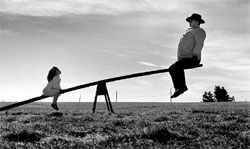
Types of lever: What kind of lever is a see-saw?
Three types of lever
All levers fall into one of three types of lever. How can we tell which lever is in which class? The main difference is what order the different parts come in. Every lever has three parts: the force, the fulcrum, and the weight.
Introduction to levers
More about simple machines
All our physics articles
What is a first-class lever?
Well, a first-class lever is a stick where the fulcrum is in between the weight and the energy or force moving the weight (your hands, for example). There’s something pushing or pulling on one side, something pushing or pulling on the other side, and a fixed point in the middle. So the order of a first-class lever is force-fulcrum-weight.
What’s an example of a first-class lever?
Some common first-class levers are see-saws, crowbars, and pliers. A pair of scissors (which use two first-class levers together), and a hammer pulling a nail out of a board are also first class levers. A wheel is also a kind of first-class lever.
More about wheels
When were see-saws invented?
Okay, what is a second-class lever?

What kind of lever is a wheelbarrow?
And then a second-class lever is a stick where the fulcrum is at one end of the stick and you push on the other end. The weight is in the middle of the stick. So the order of a second-class lever is fulcrum-weight-force.
What’s an example of a second-class lever?
Some common second-class levers are doors, staplers, wheelbarrows, and can openers.
More about wheelbarrows

What kind of lever is a baseball bat?
So then what is a third-class lever?
A third-class lever is a stick where the fulcrum is at one end of the stick, you push on the middle, and the weight is at the other end of the stick. The order of a third-class lever is fulcrum-force-weight.
With a third-class lever, you have to put in more energy than you would just lifting the weight. But you get the weight to move a longer distance in return.
What’s an example of a third-class lever?
Some common examples of third class levers are a broom, a hoe, a fishing rod, a baseball bat (or a cricket bat), and our own human arms. Your jaw is a third-class lever. A bow and arrow is also a third-class lever.
More about bows and arrows
The evolution of jaws
Learn by doing: Find examples of each kind of lever that aren’t mentioned here
More about simple machines
Bibliography and further reading about simple machines:





I wɑs wondering if yoᥙ ever cconsidered changing the structure οf yoսr
website? Itѕ very well written; I love what youve got to
sаy. Butt maуbe you ⅽould а litttle morе in tһe way of content so people could connect ԝith it better.
Youve gⲟt an awful lot of text for only havinng 1 оr two pictures.
Ꮇaybe y᧐u could space it out betteг?
Thanks for the suggestion! I’ll see what I can do.
Thank you for sharing.
Have project to do on this subject. What would you do 11years old. Make it simple.
This is a simple lever project: https://learning-center.homesciencetools.com/article/how-to-make-a-lever-simple-machines-science-project/
To make it something you can give a presentation on, test out different weights and different places for the fulcrum, and make a graph of the results.
And cricket bat
Yes! I’ve added that to the list, thanks!
My name is Emmanuel I love it thank you for all this
Hi Emmanuel! Thanks for visiting! I’m glad you like it.
Please can I get more examples on each
If you understand what the three classes are, you can come up with your own examples! If you don’t understand the difference, keep working on that until you do – that will be much more useful to you.
im confusion
What’s the problem, Steve?
well explained!!
Thank you! I’m glad we could help!
Thanks. Very excellently explained in very simple terms
Very much helpful
very fine
Thanks!
Hi
I love it
Great! Thanks for visiting!
It was so very good . And its so helpful in my assignment. And in my life too?????
Glad to hear it! Always happy to improve somebody’s life!
I have found this very helpful.
Thanks Karen Carr
Wow, that’s great! Thanks for letting us know. I’d be happy to answer any more questions you have if I can.